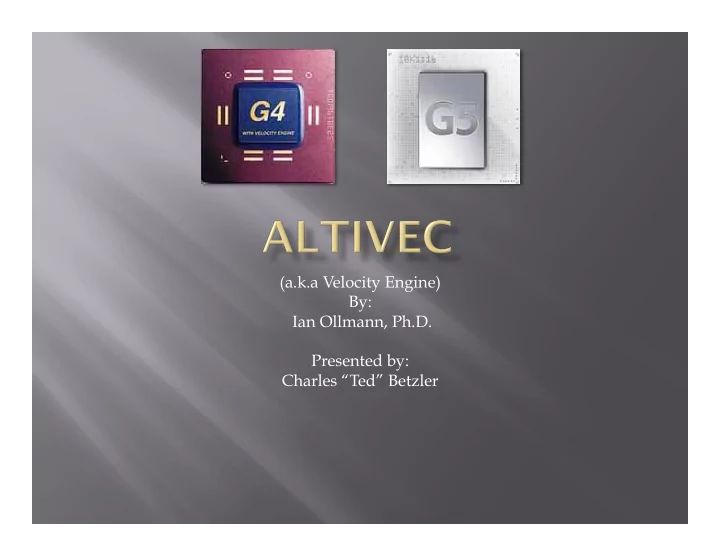

(a.k.a Velocity Engine) By: Ian Ollmann, Ph.D. Presented by: Charles “Ted” Betzler
What is AltiVec? How Do We Use It? Math Hardware Factors The Big Picture Other Resources
128-bit Vector Computation Unit Included in G4 & G5 Processors (32 of them) Pentium & other processors have similar units Separate from the integer unit and FPU SIMD – multiple pieces of data simultaneously in parallel
resultVector = vec_add( vector1, vector2): Each 128-bit Vector can hold up to 16 numbers Can outpace integer unit by factor of 16 Can outpace FPU by factor of 4 With improvements in data layout and cache usage, factor can be even higher They’re cool
Compilers: Project Builder GNU Compilers Two Programming Interfaces: Assembly C-interface C-interface maps almost 1:1 with Assembly You can build pre-compiled libraries for other languages in C Older PowerPC Must write code for older PowerPC – AltiVec Code will not run at all on older PowerPC processors
Data Types (per register): 128 bits 16 chars 8 shorts 8x16 bit pixels 4 ints 4 single-precision floats Double not supported! 2:1 parallelism not worth it? Motorola made increased FPU handling of doubles to compensate
We use the vector keyword in front of the type to declare a vector: vector char In C, a union is used to treat the vector like an array: typedef union { vector short vec; short elements[8]; }ShortVector; ShortVector shortVector; shortVector.vec = (vector short) someVectorShort; theThirdElement = shortVector.elements[2];
Type Conversions are free if bit patterns same: vector float zero = (vector float) vec_splat_u8(0); (vec_splat_u8() returns unsigned char type) Normal Type Conversions:
Some operations generic, and follow types Specific operations override types Introducing Constants into Vector Static integers can be expensive If value not in cache, 35-250 cycles! Use splat_X# to generate vectors with a set pattern vec_splat_u8(1) generates a vector full of 0x01 vec_splat_s32(1) generates a vector full of 0x00000001 vec_lvsl and vec_lvsr move integers to/from integer unit while avoiding stack This can save 5-7 cycles per integer
Addition and Subtraction vec_add() and vec_sub() Saturated: vec_adds() and vec_subs() Clips overflow Multiplication Many multiplication functions, specific to types Most do A*B+C – for plain multiplication, just pass array of 0 as C
Division Only possible with floats! Integer division uses fixed point reciprocal multiplication Very involved – please refer to manual for details! Square Roots Also only accomplished with floats Very involved – please refer to manual for details! Comparator and Permute functions available
Instruction Cache G4 has a 32 kB 8-way set associative instruction cache First iteration of loop slow, successive loops very fast Better to position often called code bocks close in memory Pipeline Most instructions take 1-5 cycles G4 Vector pipeline 3-5 stages, depending on model Must keep full of independent data to take advantage
Load/Store vec_ld() and vec_st() – aligned addresses Important to align data (as per earlier presentation) Memory Speed is Always the Problem modern PowerPC machines might be running four, five, six or even seven times as fast as their memory subsystems Streaming cache instructions Allows you to manipulate how data is stored in cache Allows you to set up “streams” and manipulate pre-fetch control Set up 64-512 byte overlapping blocks This prevents interruption by other processes
Cache L1 is a eight-way set-associative 32 kB in size Very fast L2 larger, but slower Some models two-way set associative, newer are 8-way L3 even larger and slower L2 (and L3) caches serve as a victim cache – data only comes to be in the L2 or L3 caches after being cast out of the L1 (or L2) cache Data has to be moved to the L1 cache before it can be loaded into register.
Cache penalties: Loading a 32 byte cache line from L2 takes from 10-15 cycles Loading a cache line from RAM to L1 takes about 35-40 cycles on a G4/400 If all you do is add those two vectors together (as little as 1 cycle), then during the other 39 cycles your code will do nothing It is important to keep this in mind while optimizing!
AltiVec most efficient with 64 bytes or more of data Unaligned cases are too slow Less data can be less efficient than scalar processor Efficient pipelining is very important AltiVec better at high throughput – not low latency Where AltiVec really shines is in that 10% of your program that eats up 90% of the CPU Premature optimization is the source of all evil!
C programming guide: http://www.freescale.com/files/32bit/doc/ ref_manual/ALTIVECPIM.pdf Assembly programming guide: http://www.freescale.com/files/32bit/doc/ ref_manual/ALTIVECPEM.pdf Power Developer http://www.powerdeveloper.org/ Freescale http://www.freescale.com/
Recommend
More recommend